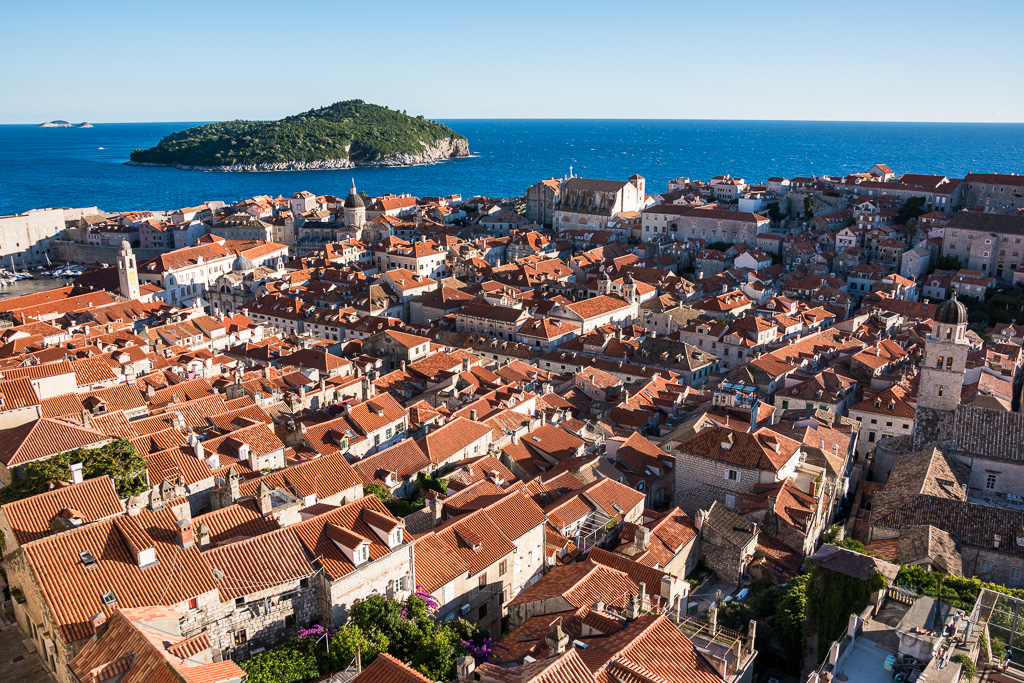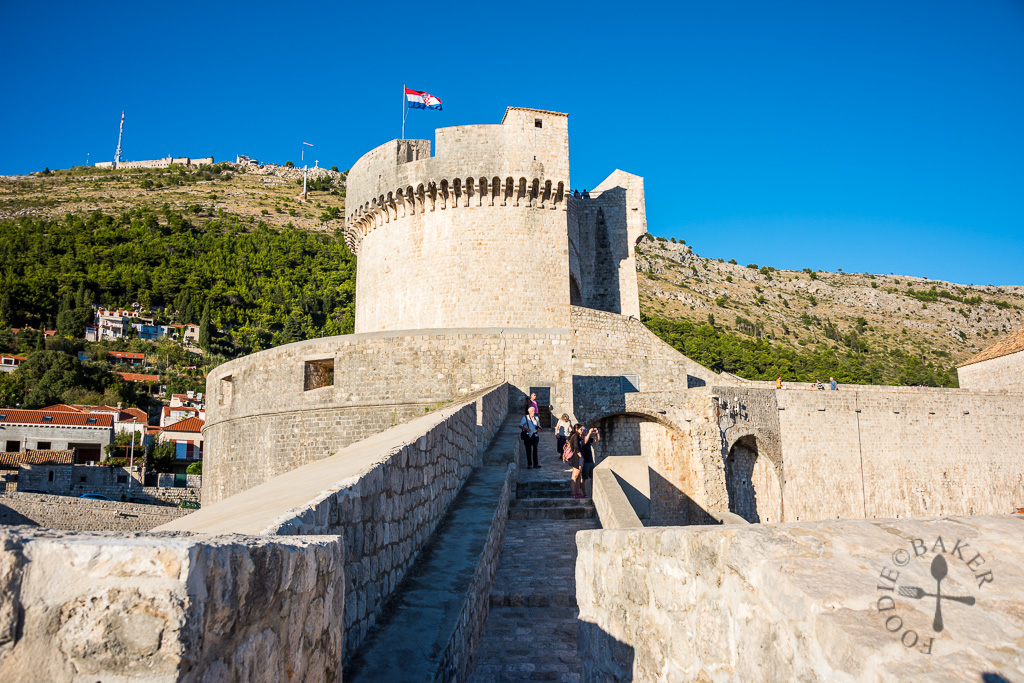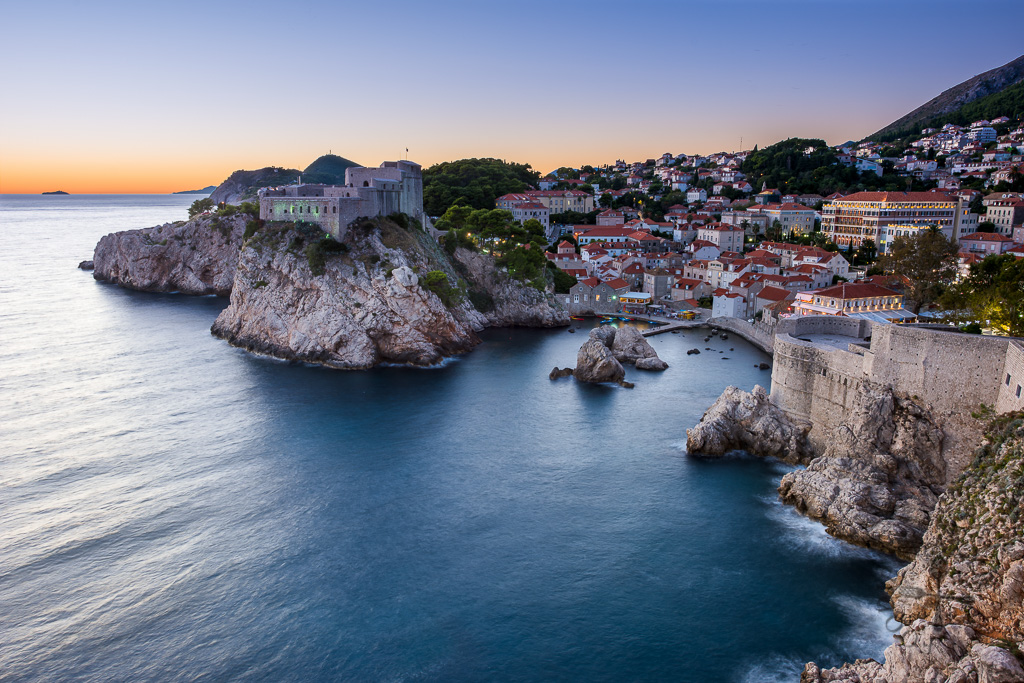
After our 2-night stay in Mostar, we left for Dubrovnik, one of the most popular cities in Croatia! We could have taken the bus, which would have cost us €15 per person (excluding luggage deposit €1 per luggage). However, we paid a few euros more and hired a private driver through our AirBnB host. It cost us €70 (worked out to be €17.50 per person) but more comfortable and we could tell our driver where we wanted to alight.

When we reached Dubrovnik, we were ravenous so we popped into a random restaurant for lunch and the food was pretty good! After lunch, we checked in to our accommodation, which was located outside the Old City. We chose to stay outside the Old City because it’s nearer to the pier (where we were going to catch a ferry to our next destination) and also because there are fewer flights of steps (imagine having to lug luggage up many steep flight of steps!)

Getting Our Data Sim Card
As we would be renting a car in Croatia, we needed Internet data so we could use the GPS navigation. The 2 tourist cards we had researched are offered by T-Hrvatski Telekom and Vip.
| T-Hrvatski Telekom | Vip | |
| Price: | HRK 85 (11€) | HRK 80 (€10.50) |
| What it includes: | Unlimited 4G internet data for 7 days + HRK 5 call credit | Unlimited 4G internet data for 7 days + 100-minute call credit |
| Top up for internet: | HRK 80 per week or HRK 15 per day | HRK 75 (€10) per week or HRK 15 (€2) per day |
Both plans are priced very competitively and they both offered standard, micro or nano SIM cards. In the end we got from T-Hrvatski Telekom as it was the first telecom that we saw when we were walking around. We bought our Sim card but activated it only 2 days later as we would be in Croatia for 9 days, and we only needed the GPS navigation towards the end of our trip in Croatia (our friends, on the other hand, activated on the spot).

Getting to Old City
Getting around within Dubrovnik can be easily done by bus – the local buses are run by the company Libertas, which offer 14 routes and the timetable and routes for all the buses can be found here. Each bus ride cost HRK 15 and can be purchased on board the bus (by cash only if I’m not wrong). However, at some bus stops, there are ticket booths where you can purchase tickets for HRK 12. You can purchase a few tickets at one go and validate them only when you board the bus, and I recommend doing so as some ticket booths open late / close early.

Brief History of Dubrovnik
Those who seek Earthly paradise should come and see Dubrovnik.
G.B. Shaw
The history of Dubrovnik goes very far back – in fact, as far as 7th century when it was first founded. The original name of the city wasn’t Dubrovnik but Ragusa, a corruption of the word Lausa, the name of the rocky island on which the city was built. The name Dubrovnik was first recorded in 1189, derived from the Slavic name dubrava, an oak grove or oak forest (which happened to surround Dubrovnik on the slopes of Mount Srđ).
Due to Dubrovnik’s prime location on the Adriatic Sea, abundant natural resources (the oak forest) and skilled labour, the city’s maritime fleet grew quickly and the city soon developed into a trade centre. In particular, Dubrovnik witnessed the most development in the 15th and 16th centuries, in which it could compete against the Venetian empire for the Adriatic waterways.
However, in 1667, a catastrophic earthquake destroyed many structures and took away the lives of more than 5,000 people. Even after the reconstruction, the decline of the Mediterranean as a trade hub further devastated Dubrovnik’s maritime industry.
Today, Dubrovnik thrives as popular tourist destination – more than 1 million tourists have visited Dubrovnik in 2016! This overwhelming popularity has also resulted in problems – it is struggling with too much foot traffic. Apparently Dubrovnik is planning to restrict the number of tourists in the Old City to 8,000 people at any one time, and unless you have the Dubrovnik City Card or have registered your arrival at least a day in advance, it’s possible that you may not be allowed to enter the Old City until the numbers drop to less than 8,000 (source). Not sure how the authorities will keep track and implement this but I guess it’s now better to visit Dubrovnik during the off season!

There are quite a few things that travellers can do in Dubrovnik – such as visiting museums, palace and other historical monuments; do some water sports like diving, kayaking and jet skiing; take a cable car ride up Mount Srđ; cruise out to other islands etc… Even if you are not interested in any it’s okay, because we didn’t do those activities too (we did our boat cruise at another island). However, there’s one thing that must not be missed – the City Walls.

City Walls of Dubrovnik
Fortifications around Dubrovnik (then called Ragusa) began in early Middle Ages (about at the end of the 8th century), and were built and expanded throughout the centuries. In the 9th century, Ragusa was already so well fortified that it could resist the Saracens who besieged the city for 15 months. The City Walls today run uninterrupted for 1,940 meters, completely surrounding the Old City, including the Old Port, with defensive walls and forts.

There are a total of three entrances to the City Walls. The first is easily located just across the Onofrio’s Fountain, the large fountain that can be seen upon entering the Old City via the Pile Gate. The second entrance is located close to the inner Ploce Gate. And the third entrance – the hardest to find – is located behind St. John Fortress at the entrance to the Maritime museum.
| 1 Apr – 30 May 1 Aug – 31 Sep | 0800 – 1830 |
| 1 Jun – 31 Jul | 0800 – 1930 |
| 1 Oct – 31 Oct | 0800 – 1730* |
| 1 Nov – 31 Mar | 0900 – 1500 |
*The official website stated that the closing time to be 1730 hours, however, when we were there in early October, the closing time was 1830 hours. So it’s best to check directly with the ticket office when you are there!
| Price: | HRK 150 (adult); HRK 30 (under 18 and students, students need to produce student ID) |
| Essential: | Comfortable walking shoes; hat and sunglasses to shelter from the sun; water to rehydrate; and camera to capture the stunning views! |
The opening hours and entrance fees are as above – do give yourself at least 2 hours to fully walk through the whole length of the City Walls (even though last entrance is 1 hour before closing time). Keep your ticket with you (don’t lose it!) as whenever you pass by an entrance, the ticket officer will scan the ticket again. If you want to end the walk with the best views, start the walk from the third entrance – read on to see what the view is!

The third entrance is located near the Old Port, so our views at the start were of the incredibly beautiful and clear sea and the many yachts parked at the port.

As we continue walking along the walls, we were heading inwards to the Old City, so the views were slowly being replaced by Dubrovnik’s iconic orange-tiled roofs. These yellow and red clay (aka terracotta) tiles are the most eye-catching and characteristic roofing materials used during medieval times. When Dubrovnik was bombed by the Yugoslavian People’s Army in 1991 during the Croatian War of Independence, more than 400 buildings within the Old City were damaged, especially the roofs as they took direct hit from the artillery bombardment.

The traditional roofing tiles used in Dubrovnik (from the Middle Ages) are called Kupe Kanalice, a hand-manufactured tile moulded in the shape of human thighs. The shaped tiles were then put into a kiln and fired at 1,000C / 1,830F! The colour of the tiles varies from yellow to orange to red and even brown, depending on the type of clay used and how far from the heat source the tiles were heated in the kiln. However, as the factory that manufactured these tiles in Dubrovnik closed down in the 1950s, a more modern technique was employed to manufacture the tiles, hence most of the new tiles we see in Dubrovnik today are a uniform bright orange colour.

Dominican Monastery was established as early as 1225 in Dubrovnik, but the building of the monastery and the rest of the complex was completed only in the 14th century. Also a museum today, the monastery exhibits many paintings, artifacts and jewellery. Entrance to the monastery and museum costs HRK 50.

Lokrum Island is a small nature reserve located a short 15-minute ferry ride away from Dubrovnik that is open for visiting from April to November. It is also possible to kayak to the island if you are up for some fun!

Minčeta Tower was built in 1319 by a local builder, Nicifor Ranjina, on the land owned by the Menčetić family (hence the name of the tower). The tower underwent several reconstruction to achieve its current look – with 6-metre thick walls surrounding the tower and a series of gun ports. As Minčeta Tower is the highest point in Dubrovnik’s defence system, it’s the best place to climb up for a panoramic view of the city.

The Onofrio’s Fountain is a sixteen-sided fountain built from 1438 to 1440, used as an ending point of the aqueduct system in Dubrovnik.

The 300-metre long Stradun (aka Placa) is the main street of Dubrovnik. Its name Stradun is a Venetian nickname which means Big Street, while the name Placa is derived from the Greek and Latin word Platea, which means street. Originally the site was once a channel, which separated the city into northern and southern halves. Earth was filled into the channel at the end of the 11th century to join the two halves and it was paved with limestone in 1468. Today, many historic buildings and monuments lie along Stradun and important events are often held there too. I particularly like walking down the street in the morning, when the crowd is lighter and the street significantly quieter.

And the best way to end the walk along the city walls has got to be this view! We were in Dubrovnik in early October, so we managed to catch the sunset. In summer, it wouldn’t be possible because the sun sets much later, after the City Walls are closed. I think we spent a good 30 minutes (or maybe more) here waiting and watching the sunset, which was so beautiful it’s hard to describe in words – you have to be there to see for yourself!


At about 1830 hours (the time that the City Walls are closed), the staff came chasing us down the City Walls (politely of course). So we head down for some blue hour shots before dinner.

The original Bell Tower (aka Clock Tower) was built in 1444 and aligned to the centre of Stradun. However, after the 1667 earthquake, the Bell Tower started leaning and it was finally demolished in 1929, with a new one rebuilt according to the same design.
The Orlando Column is a medieval knight (named Orlando) bearing a sword and shield carved into a stone column erected in 1419. On some days, the column will support a flag pole. According to legend, the knight, Orlando, and his fleet saved Dubrovnik from a 15-month long Saracen siege, hence the column was built in his honour. But in reality, it was meant to symbolise Dubrovnik’s sovereignty and freedom.
St Blasius Church (aka Sveti Vlaho in Croatian) is a baroque church erected in honour of the patron saint, St. Blasius. The church, built in 1715, was built on top of an old Romanesque church from 1368 that was burned down in 1706.


We had dinner at Kamenice, a restaurant which offers seafood and other dishes at slightly more affordable prices compared to other restaurants nearby. We had beer, mussels, fried calamari, creamy green (parsley) tagliatelle pasta, octopus salad and black (squid) risotto which came up to be about HRK 500 including tips (SGD 100). My favourite was the octopus salsa which is slightly tangy and sweet while I felt the rest was average. The dinner queue starts after 7 p.m. so it’s best to go early to avoid the queue!
Gundulićeva poljana 8
(+385-20) 32 36 82
Apr – Oct 0800 – 0100
Nov – Mar 0800 – 1600
(Not official opening hours, so best to check with the restaurant directly)

If you are interested in viewing the City Walls, you can climb up to Lovrijenac, a fortress built on a 37-meter high rock overlooking the Adriatic Sea. The fortress was assessed to be built in the 11th century – apparently the Venetians wanted to build their own fortress on this spot and use it to conquer Dubrovnik. But when the people of Dubrovnik learned of this plan, they decided to build their own fortress on this exact spot, in mere 3 months! Throughout the centuries, St. Lawrence Fortress remained an important stronghold of Dubrovnik, protecting the city against attack from land and sea.
The ticket to enter Lovrijenac is combined with the City Walls’ ticket, and both tickets don’t have to be utilised on the same day – we actually visited Lovrijenac two days later. Events are conducted at Lovrijenac frequently and this year 2017, they are staging Shakespeare’s Hamlet there!

And that’s it for our stay in Dubrovnik! We rented a car to Montenegro the next day, so stay tuned for the next travelogue! Meanwhile, you can check out the previous travelogue in Mostar, Bosnia and Herzegovina and our 25-day Balkans itinerary:
| ← Previous travelogue | |
 |  |
Karen says
Fantastic photography of a very beautiful and interesting tour. Thanks so much for sharing. I was surprised at the crowds in early October…although the nice weather might have something to do with that.
Jasline N. says
Thannk you Karen! Yea Dubrovnik was quite crowded when we were there in October, can you imagine if it’s summer? I think the crowds will be even more crazy!
apuginthekitchen says
So beautiful and your photo’s are amazing.
Jasline N. says
Thank you Suzanne! 🙂 Wishing you a great week ahead!